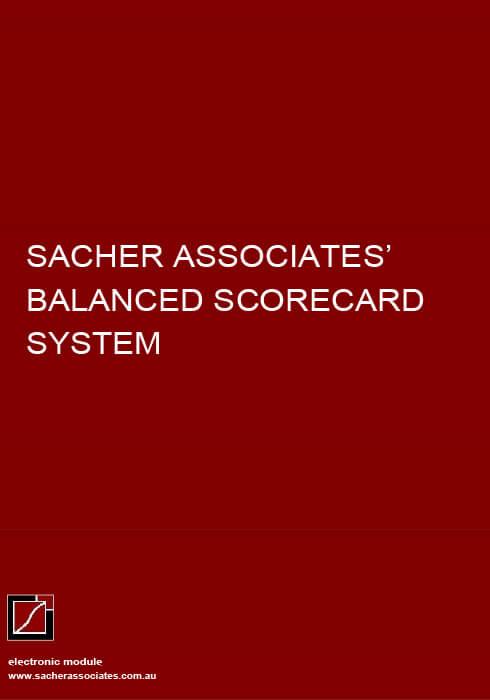
Balanced scorecard EBook
Publisher: Independent Pubs
Author: Harold Monty Sacher and Merryl Sacher
Format: EBook
Pages: 314
Released: 2007
The balanced scorecard book is a total process for implementing strategy so as to achieve total stakeholder satisfaction. It incluses a potent system for measuring and managing individual, team and organisational performance. With case studies and examples, this practical book enables you to build and implement a performance measurement, management system. It provides a jargon-free, practical guide to measurable, definable performance improvement.
The balanced scorecard has become synonymous with a systematic approach to implement strategy. It can be used as a framework to translate the organisation's vision, mission, values and strategic goals into the everyday outputs, measures and targets of the people doing the work.
Many strategic plans do not work well because they are not implemented. The workforces of many companies go about their daily business activities unaware of the fact that the company even has a business plan. As a result, there is no relationship between the plans and the workers' activities.
Unfortunately, many businesses lack a mechanism or system to translate their abstract visions and plans into measurable outputs, so that every person in the organisation knows exactly what outputs they are expected to produce and how those outputs are to be measured. This would ensure that everybody knows exactly what they have to do on Monday morning in order to achieve results. This module outlines the balanced scorecard process to hierarchically and mathematically connect the organisation's vision to the daily actions of the people doing the work. It is a process to implement strategy.
The starting point would be the identification of the business unit, and the development of the business unit's strategic plan. This would involve the development of a vision, mission, strategy, outputs, measures, targets and feedback systems for the business unit. These are then cascaded down the business unit in such a way that it is localised, meaningful, understood and owned by every team in the business unit. The cascading process ensures alignment and linkage between the business units strategic goals and the outputs, measures, targets and action plans of the people doing the work.
Such a process enables resource allocations, annual budgets and strategic decisions all to be driven by the strategy. Performance reviews can be used to monitor individual performance which in turn monitors organisational performance. Reward systems can be designed to reward organisational performance achievement. The vital link between performance management and strategic goals can be made. The performance management system becomes a process to implement strategy.
Building the balanced scorecard: the process
- Identify an autonomous business unit
- Develop a strategic plan
- Identify stakeholders
- Develop outputs, measures and targets
- Weight the targets
- Identify the information requirements
- Implementation
Book content
Balanced scorecard overview
This module provides an overview of the balanced scorecard system. The modules that follow fill in the details, but this module shows how it all fits together.
Big picture
There is a lot more to total and continuous performance improvement than just measuring performance, or developing goals, or putting in a new system. One of the dangers of working in an unsystematic and piecemeal manner is that it is possible to do more harm than good to the complex arrangement of systems that make up an organisation. Nothing short of a purposeful, total and systematic approach will suffice if continuous, and especially sustained, performance improvement is to be achieved.
The Big Picture provides a summary of our total system approach to performance improvement, which we call the basic components of team performance. These are the basic components necessary to improve performance: individual performance, team performance and organisational performance. The aim is to implement these basics to a level where sustained performance improvement can be achieved.
Unified sense of direction
This basic component of team performance is best summed up by the phrase, one team, one direction. Achieving this requires a shared vision. The entire company, and all the teams and the individuals which make it up, must be pulling in the same direction. Every member of every team needs to accept responsibility for that part of the company over which they have some control.
To achieve a unified sense of direction there needs to be agreement at all levels on what the organisation values, what it does, where it is headed and how it plans to get there. The first step requires clarity, focus and agreement about the organisation's values, vision and mission. Values, vision and mission on their own, however, do not equal a unified sense of direction. They are organisational tools used sometimes well, and sometimes not so well, to create a sense of direction. A workbook component is included to help you apply the concepts.
Environmental analysis
The purpose of this section is to help you assess how your organisation is currently operating. This module will help you:
- Identify how your organisation is currently operating in terms of the strengths and weaknesses the organisation possesses in the internal environment, and the opportunities and threats it faces in the external environment;
- To enable you to develop a strategy that will utilise your organisations strengths; manage its weaknesses; take advantage of the opportunities in the environment and minimise the impact of the environmental threats.
- Clarifying where the organisation is going in the future, and analysing where it is now is important. The rest of the business plan will revolve around closing the gap between where the organisation wants to be and where it is now.
- A workbook component is included to help you apply the concepts.
Strategy formulation
- Once you have worked out where the organisation wants to be in terms of a vision, mission and values, and dealt with where the organisation is now in terms of an environmental scan, you then need to deal with how the organisation gets from where it is, to where it wants to be.
- Strategy is the overall game plan or map to help direct the organisation from where it is to where it wants to be. Strategy is usually expressed in medium term (1 to 3 year) statements or goals about where the organisation is going.
- A good strategic plan, which includes a vision, provides the blueprint for coordination, direction and teamwork.
- A workbook component is included to help you apply the concepts.
Total stakeholder satisfaction
- To optimise the organisation system there needs to be an emphasis on the rigorously measured demands and expectations of all stakeholders. Stakeholders could include owners, external customers, internal customers, the government, employees and suppliers. A firm understanding of the customer's and stakeholder's identity is essential for achieving results. You can't satisfy customer and stakeholder needs unless you know exactly who the customers and stakeholders are. Once stakeholders have been identified, their expectations must be clearly defined so that team's can focus around meeting and exceeding expectations. A workbook component is included to help you apply the concepts.
- Suggested modules to complete together with this one: How to develop Outputs and Performance Measures; Target Setting.
How to develop outputs and performance measures
- The process of translating strategy into daily action begins with stakeholder identification, followed by a rigorous process of identifying stakeholder expectations. This module on how to develop outputs and performance measures are the first two steps in a three-step process.
- Outputs are the value-added end results of a process which are produced by an individual or a team for an internal or external customer.
- Performance measures are units of measure used to assess whether outputs are achieved.
- This module shows how to develop outputs and performance measures.
- Step three, Target Setting is dealt with in a module of its own.
- A workbook component is included to help you apply the concepts.
- Suggested modules to complete together with this one: Total Stakeholder Satisfaction, Target Setting.
Target setting
Note: This module should be completed together with How to develop Outputs and Performance Measures for a complete understanding.
- Targets are written aspirations for what the organisation must achieve in the short term to achieve breakthrough performance in its strategic goals. Targets are expectations of short term achievement along the long term strategic path the organisation has chosen. They are short term milestones, identifying where they expect to be weekly, monthly, quarterly or annually, along the road to strategic goal achievement.
- Targets define, in precise terms, particular levels for the delivery of outputs. They tell us what we should achieve in terms of quality and quantity, as well as the time frame for the achievement of the target. Targets drive, measure, control and improve performance. They are a key contributor to organisation success.
- This module shows how to set targets against outputs and performance measures and develop the Balanced Scorecard.
- A workbook component is included to help you apply the concepts.
Resource requirements and action planning
- Any target-setting system is only as successful as the results it achieves after it has been implemented.
- To achieve targets, resources and action plans are required.
- Resources could include the equipment, materials, skills, people and money needed to achieve targets.
- Action plans refer to a step-by-step plan which will lead to the achievement of a target.
- This module concerns itself with defining the resource requirements and putting the plan into action.
- A workbook component is included to help you apply the concepts.
Performance-linked communication
- Performance-linked communication is a systematic method of establishing performance feedback in an organisation.
- Performance-linked Communication focuses on communication from a performance point of view. It answers the question 'What communication skills, systems and processes are needed to improve performance, to improve the delivery of outputs to customers and stakeholders?' A successful communication system must have entrenched mechanisms for communicating, analysing and discussing performance feedback on the outputs produced for customers and stakeholders so as to continuously improve productivity, quality and team work.
- A workbook component is included to help you apply the concepts.
- For a complete how to guide to building a performance-linked communication system, we refer you to our Performance-linked Communication System.
Implementation: guidelines and pitfalls
- Provides guidelines for implementation and pitfalls to avoid when implementing any performance improvement/change management system into an organisation. This module is based on the experience gained and the lessons learned from over 20 years of hands-on implementation in the field.

